Canadians' EV Interest Dips For Third Consecutive Year

Table of Contents
Rising Costs and Inflation Impacting EV Affordability in Canada
The increased cost of living and economic uncertainty are significantly impacting the affordability of electric vehicles in Canada. Higher interest rates and inflation are making it harder for consumers to justify the often-higher upfront cost of an EV compared to a gasoline-powered car.
Increased Vehicle Prices
Electric vehicle prices have skyrocketed in recent years. While government incentives aim to offset these costs, the increase in base prices is still a major barrier to entry for many Canadians.
- Price Comparison: A comparable gasoline-powered sedan might cost $30,000, while a similar EV could easily exceed $45,000, even after factoring in federal and provincial rebates. The price gap is even more significant for luxury EVs.
- Government Incentives: While programs like the federal iZEV program provide rebates, these are often insufficient to fully bridge the price gap between EVs and gasoline vehicles, particularly for higher-priced models. The effectiveness of these incentives is diminished by rising EV prices.
- Data Sources: Statistics Canada data on vehicle sales and pricing, coupled with reports from organizations like the Canadian Automobile Dealers Association (CADA), confirm this upward trend.
Economic Uncertainty and Consumer Confidence
General economic uncertainty and inflation are eroding consumer confidence, leading many to postpone large purchases like electric vehicles.
- Consumer Confidence Indices: Data from the Conference Board of Canada reveals a decline in consumer confidence in recent quarters, reflecting anxieties about job security, rising interest rates, and the overall economic outlook.
- Impact on Spending: This decreased confidence directly translates into a reluctance to invest in expensive items, including electric cars, even with government incentives.
- Expert Opinion: Economists and automotive analysts predict that the current economic climate will continue to suppress demand for EVs until consumer confidence improves.
Range Anxiety and Charging Infrastructure Gaps in Canada
Range anxiety, the fear of running out of battery charge, remains a major hurdle to EV adoption in Canada. This is exacerbated by gaps in the charging infrastructure, especially outside of urban areas.
Limited Charging Station Accessibility
The lack of sufficient and reliably functioning charging stations across Canada, particularly in rural and remote regions, remains a significant barrier to EV adoption.
- Charging Station Density: Canada lags behind many other developed countries in terms of charging stations per capita. This disparity is particularly pronounced outside major cities.
- Regional Disparities: Charging infrastructure is heavily concentrated in urban centres, leaving many rural Canadians without convenient access to charging. This uneven distribution limits the practicality of EV ownership for a substantial portion of the population.
- Charging Speed and Compatibility: Inconsistencies in charging speeds and compatibility between different EV models and charging stations add to the complexity and frustration of EV ownership.
Concerns About Driving Range and Cold Weather Performance
Cold weather significantly impacts the driving range of electric vehicles, compounding range anxiety for Canadian drivers.
- Cold Weather Impact: Battery performance decreases in cold temperatures, leading to reduced range and longer charging times.
- Technological Advancements: While advancements are being made in battery technology to mitigate these effects, the cold-weather performance of EVs still remains a concern for many potential buyers.
- Anecdotal Evidence: Many online forums and reviews highlight the challenges faced by Canadian EV owners during winter months, further fueling concerns about range and performance.
Government Incentives and Policies: Effectiveness and Future Directions
Government incentives play a vital role in stimulating EV adoption. However, their current effectiveness in Canada is debatable.
Current Federal and Provincial Incentives
Various federal and provincial programs offer rebates and incentives for EV purchases, but their impact is limited by the factors discussed earlier.
- iZEV Program: The federal Incentive for Zero-Emission Vehicles (iZEV) program provides rebates for eligible electric vehicles, but these are often insufficient to fully offset the higher purchase price.
- Provincial Programs: Many provinces offer additional rebates and incentives, but the eligibility criteria and amounts vary significantly, leading to inconsistencies across the country.
- Uptake Statistics: While the iZEV program has seen a considerable number of applications, the overall impact on EV sales remains constrained by economic factors.
Future Policy Recommendations
To effectively boost Canadian EV adoption, significant policy changes are necessary.
- Expanding Charging Infrastructure: A nationwide investment in charging infrastructure, particularly in rural and remote areas, is crucial. This should include a focus on fast-charging stations and ensuring compatibility across different EV models.
- Improving Access to Financing: Government-backed financing options, such as low-interest loans or lease programs, could make EVs more accessible to a wider range of consumers.
- Addressing Consumer Concerns: Public awareness campaigns addressing range anxiety, cold-weather performance, and the benefits of EV ownership are essential to build consumer confidence. Clear and consistent messaging about government incentives is also vital.
Conclusion
The decline in Canadian EV interest for three consecutive years is a complex issue with multiple contributing factors. High costs, limited charging infrastructure, and concerns about range and cold-weather performance are significant hurdles. While government incentives exist, their effectiveness is currently hampered by the overall economic climate and the high price of EVs. Understanding these challenges is crucial for the future of electric vehicle adoption in Canada. To stimulate growth, policymakers must prioritize expanding charging infrastructure, improving access to financing, and addressing consumer concerns through targeted initiatives and clear communication. Stay informed about government incentives and charging infrastructure developments to make informed decisions about your next vehicle and contribute to a greener Canada. Visit the websites of Natural Resources Canada and your provincial government for details on EV incentives and charging station locations.

Featured Posts
-
 Power Finance Corporation Pfc Dividend Update 4th Cash Reward For Fy 25
Apr 27, 2025
Power Finance Corporation Pfc Dividend Update 4th Cash Reward For Fy 25
Apr 27, 2025 -
 Cannes 2025 Juliette Binoche To Head The Jury
Apr 27, 2025
Cannes 2025 Juliette Binoche To Head The Jury
Apr 27, 2025 -
 Belinda Bencics Return Abu Dhabi Open Final
Apr 27, 2025
Belinda Bencics Return Abu Dhabi Open Final
Apr 27, 2025 -
 Where To Buy Ariana Grande Lovenote Fragrance Set Online A Price Comparison
Apr 27, 2025
Where To Buy Ariana Grande Lovenote Fragrance Set Online A Price Comparison
Apr 27, 2025 -
 Trumps Trade Concessions A Warning For Canadian Voters From Carney
Apr 27, 2025
Trumps Trade Concessions A Warning For Canadian Voters From Carney
Apr 27, 2025
